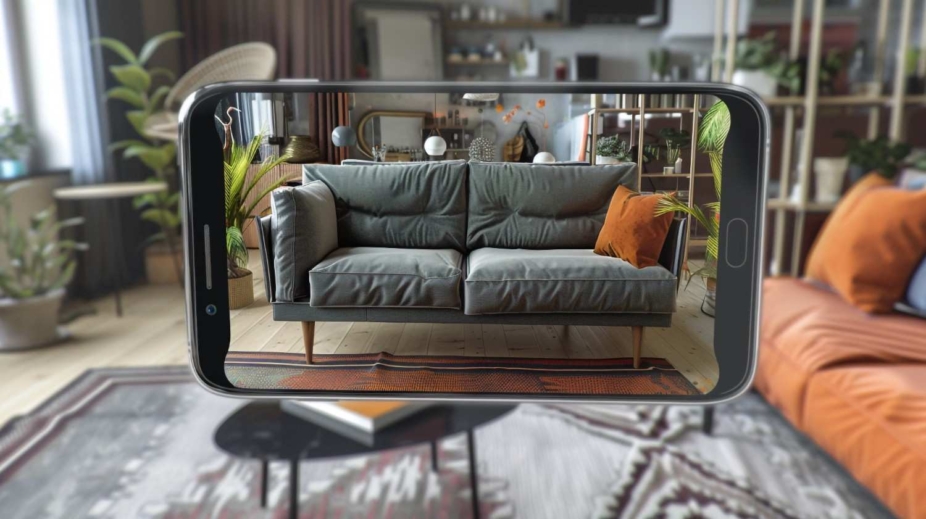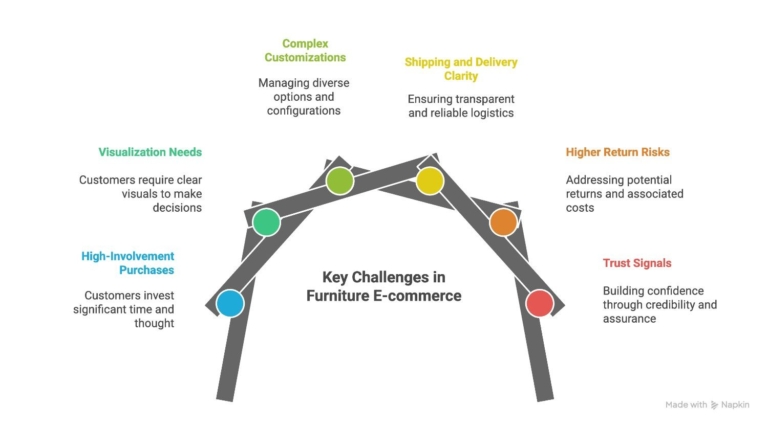Greetings! I'm Aneesh Sreedharan, CEO of 2Hats Logic Solutions. At 2Hats Logic Solutions, we are dedicated to providing technical expertise and resolving your concerns in the world of technology. Our blog page serves as a resource where we share insights and experiences, offering valuable perspectives on your queries.

Quick Summary
A successful furniture e-commerce store needs features that help customers visualize products, compare options, trust the quality, and check out smoothly. Tools like 3D/AR views, advanced filters, size guides, customization options, reviews, and fast mobile performance make shopping easier and reduce returns. Add strong SEO, quick support, and flexible payment options to increase conversions and boost overall store growth.
Furniture ecommerce has changed fast. Today’s customers aren’t buying a table or a sofa, but actually they’re buying confidence. They want to see every detail, customize materials, compare finishes, and know exactly how the piece will fit into their space before they click “Buy.”
For furniture brands, this means one thing. Your ecommerce store needs more than beautiful photos. It needs the right features that build trust, reduce returns, and help customers make big decisions online.
In this blog, we’ll break down the must-have features every successful furniture e-commerce store needs. And also get to know how platforms like Shopware make it easier to deliver.
Planning to Upgrade Your Furniture Store?
Let’s Discuss Your Requirements
What Makes Furniture Ecommerce Different?
Selling furniture online isn’t the same as selling fashion, gadgets, or everyday products. Furniture e-commerce comes with its own challenges, and understanding them helps you build a store that truly supports how customers buy high-value items.
Pro Tip: Use AR to Reduce Return Rates
If your furniture store faces high return rates, add an AR ‘Place in Room’ feature. Most customers abandon carts because they can’t visualize size and fit. AR reduces those doubts and improves conversion.
Here are the key factors that make furniture selling unique:

1. High-Involvement, High-Value Purchases
A sofa, bed, or dining table isn’t an impulse buy. Customers compare styles, materials, colors, and prices before making a decision. That means your store must offer rich product information, strong visuals, and tools that help people feel confident about their choice.
2. Customers Need to Visualize Before Buying
Furniture must “fit” not just in size but also in style.
Shoppers want to know:
- Will this match my room aesthetic?
- Is the color accurate?
- How will it look with my walls or flooring?
This places extra importance on 3D views, AR previews, room planners, and product configurators.
P.S. For more, we’ve added a free downloadable Furniture Ecommerce Pro Tips Guide for you.
Download Guide
Get our comprehensive guide delivered to your inbox.
3. Variants and Customizations Are Complex
Furniture comes in:
- Multiple materials
- Dozens of fabrics
- Different colors
- Various dimensions
- Optional add-ons
Managing these combinations requires a platform that can handle complex variants and custom logic, something Shopware does exceptionally well.
4. Shipping, Handling, and Delivery Need Clarity
Oversized shipping, freight costs, installation services, and delivery timelines all influence conversions.
Customers expect:
- Transparent delivery options
- Assembly information
- Clear return policies
Without this, buyers hesitate.
5. Higher Risk of Returns and Higher Cost When They Happen
A sofa returned due to “wrong shade” or “didn’t fit the room” costs brands time, money, and logistics effort. The right e-commerce features help set clear expectations and significantly reduce return rates.
6. Strong Trust Signals Are Essential
For furniture buyers, trust matters.
They look for:
- Customer photos
- Reviews & ratings
- Brand credibility
- Warranty information
A furniture e-commerce store must actively build that trust at every step.
Must-Have Features Every Successful Furniture Ecommerce Store Needs
Furniture is one of the most researched and high-involvement online purchases. People don’t buy a sofa or dining table on impulse. There will be proper planning behind it; they compare materials, visualize how it fits their room, check delivery timelines, and make sure the quality is worth the investment.
That’s why furniture ecommerce stores need more than standard product listings to convert visitors into confident buyers.

Below are the features that actually work for the real projects.
1. A Furniture Product Configurator
Furniture shoppers want control. They want to mix fabrics, colors, materials, and sizes until the product feels right for their home.
A good configurator should:
- Show real-time previews.
- Display updated pricing as customers customize.
- Prevent invalid combinations.
- Support 3D or AR so customers can see the piece in their room.
Why it matters:
It removes the biggest buying fear of “What if it doesn’t look like I imagined?”
In our Shopware furniture projects, stores with configurators saw higher engagement and a noticeable boost in conversion rates.
LINK TO CASE STUDY
2. 3D, 360°, & AR Visualization
Furniture is all about look, scale, and texture. Good visuals make online buying easier.
Customers should be able to:
- Rotate the product 360°.
- Zoom into fabric details.
- View the furniture in their own room using AR.
- See real dimensions, not just approximate visuals.
This helps to build trust instantly and reduces returns. These are common in furniture e-commerce, where sizing errors occur frequently.
3. Search & Filtering Designed for Furniture Buyers
A generic filter like “color” and “size” doesn’t work here.
Furniture buyers search by:
- Style (Scandinavian, Modern, Minimalist)
- Material (solid wood, velvet, rattan)
- Room type (living room, balcony, workspace)
- Dimensions
- Budget
When buyers can quickly find what fits their space, decision-making becomes effortless. This can have a direct impact on conversions.
4. Rich, Informative Product Pages That Build Confidence
Furniture shoppers want more details. More than any other category.
High-performing product pages include:
- Lifestyle photos showing how it fits in real homes
- Close-ups of stitching, grains, textures
- Accurate dimension diagrams
- Material care instructions
- Delivery, assembly, and warranty details
This is where you win trust. A well-explained product page stops hesitation. This is one of the biggest barriers in furniture e-commerce.
5. “Shop the Room” or “Complete the Look” Suggestions
A customer looking at a sofa may also need:
- A rug
- A center table
- Side lamps
- Cushions
Showing complementary pieces increases AOV naturally. This is also where AI recommendations shine. They help customers put together a full room style without scrolling endlessly.
6. Transparent Delivery, Packaging & Assembly Information
Furniture buyers worry about:
- Delivery delays
- Damages
- Difficult assembly
- Hidden shipping fees
Make this easy:
- Show estimated delivery dates
- Add a clear shipping calculator
- Offer paid assembly services
- Display packaging details (cartons, weight, number of boxes)
This reduces checkout abandonment by a huge margin.
7. Easy and Flexible Payment Options
High-priced furniture benefits from options like
- BNPL (Buy Now Pay Later)
- EMI
- Partial advance payments
- Dedicated B2B quotes for bulk furniture buyers
Furniture buyers love flexibility, especially when the purchase is above the average budget.
8. Saved Carts, Saved Rooms & Wishlist Features
Furniture buying takes time. People revisit multiple times and often compare with family members.
Make it frictionless:
- Allow users to save multiple room setups
- Save product configurations
- Share room layouts with others
- Send automated reminders for abandoned carts
These small features reduce drop-off over long decision cycles.
9. Smooth After-Sales Support & Order Transparency
A good furniture e-commerce experience doesn’t end with checkout.
Offer:
- Order tracking
- Assembly instructions
- Warranty activation
- Replacement request flow
- AI-powered support for FAQs
This builds trust, and trust brings repeat customers.
Conclusion
Furniture isn’t an impulse buy. Your customers need to imagine, compare, customize, and trust before they finally click Buy Now.
That’s why the most successful furniture e-commerce stores today are the ones that invest in better experiences, not just better product listings. Every improvement directly impacts confidence, conversions, and repeat sales.
And the good news?
You don’t need a complicated tech stack to achieve all this.
A flexible platform like Shopware already supports the advanced features furniture brands rely on, like configurators, AR product views, custom rules, B2B modules, and seamless integrations.
We’ve seen how powerful this can be through our own furniture projects, like custom sofa beds to complex blind configurators. The results are all about better engagement, smoother shopping experiences, and more qualified buyers reaching checkout.
If you’re planning to upgrade your furniture ecommerce store or build one from scratch, now is genuinely the best time to rethink the experience your customers get online.
They already know what they want. Your store just needs to help them see it clearly.
Looking to implement these features in your furniture store? Our team would be happy to help you plan the right approach based on your business model.
FAQ
What features do I need to make my furniture e-commerce site more user-friendly?
Clear product filters, room visualization tools, detailed specs, mobile-first design, and smooth checkout improve user experience instantly.
How can I reduce returns for my online furniture store?
Add AR/3D views, size guides, fabric swatches, accurate measurements, and comparison tools to help customers make confident decisions.
Which features help increase sales for online furniture brands?
Personalized recommendations, bundle/room sets, financing options (EMI/BNPL), abandoned cart recovery, and live chat support drive more conversions.

Related Articles








